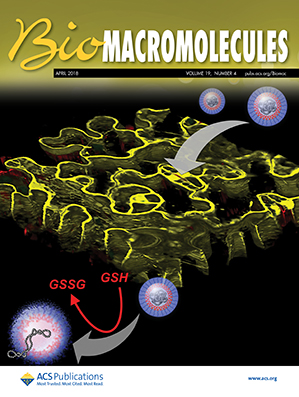抗菌活性强、毒性低的环聚α-氨基酸季铵盐。
IF 5.4
2区 化学
Q1 BIOCHEMISTRY & MOLECULAR BIOLOGY
引用次数: 0
摘要
阳离子抗菌聚合物已被广泛研究作为抗生素的替代品,以解决抗生素耐药细菌的挑战。然而,它们不可避免的细胞毒性极大地限制了它们的实际应用。环环化策略为解决这一困境提供了参考。本研究设计并合成了一系列具有较强抗菌活性和低毒性的环阳离子聚α-氨基酸季铵盐。值得注意的是,最佳聚合物cPCHLG10-C8具有显著的抗菌活性和较低的细胞毒性,对金黄色葡萄球菌的选择性指数(SI = 128)是相应线性结构lPCHLG10-C8 (SI = 16)的8倍。圆二色光谱结果表明,环状结构通过降低α-螺旋构象的程度来降低细胞毒性。此外,cPCHLG10-C8具有快速杀菌特性,诱导细菌耐药的倾向可以忽略不计,并能有效抑制或清除细菌生物膜。此外,在小鼠表皮创面感染模型中,cPCHLG10-C8显示出明显的体内抗菌作用。因此,本研究为设计平衡抗菌活性和生物相容性的阳离子聚合物提供了一种有前途的方法。本文章由计算机程序翻译,如有差异,请以英文原文为准。
Cyclic Poly(α-amino acid) Quaternary Ammonium Salt with Potent Antibacterial Activity and Low Toxicity
Cationic antibacterial polymers have been extensively investigated as alternatives to antibiotics to address the challenges of antibiotic-resistant bacteria. However, their inevitable cytotoxicity significantly restricts their practical application. Cyclization strategies provide a reference for solving this dilemma. In this study, we designed and synthesized a series of cyclic cationic poly(α-amino acid) quaternary ammonium salts with potent antibacterial activity and low toxicity. Notably, the optimal polymer, cPCHLG10-C8, demonstrated remarkable antibacterial activity coupled with low cytotoxicity, exhibiting a selectivity index (SI = 128) against S. aureus that was 8-fold higher than the corresponding linear structure lPCHLG10-C8 (SI = 16). Circular dichroism spectroscopy results indicated that the cyclic structure contributed to reduced cytotoxicity by diminishing the degree of α-helix conformation. Additionally, cPCHLG10-C8 displayed rapid bactericidal properties, negligible propensity to induce bacterial resistance, and effectively inhibited or cleared bacterial biofilms. Furthermore, in a mouse epidermal wound infection model, cPCHLG10-C8 showed outstanding in vivo antibacterial effects. Hence, this study offers a promising approach for designing cationic polymers that balance antimicrobial activity and biocompatibility.
- Download: Download high-res image (166KB)
- Download: Download full-size image
求助全文
通过发布文献求助,成功后即可免费获取论文全文。
去求助
来源期刊

Biomacromolecules
化学-高分子科学
CiteScore
10.60
自引率
4.80%
发文量
417
审稿时长
1.6 months
期刊介绍:
Biomacromolecules is a leading forum for the dissemination of cutting-edge research at the interface of polymer science and biology. Submissions to Biomacromolecules should contain strong elements of innovation in terms of macromolecular design, synthesis and characterization, or in the application of polymer materials to biology and medicine.
Topics covered by Biomacromolecules include, but are not exclusively limited to: sustainable polymers, polymers based on natural and renewable resources, degradable polymers, polymer conjugates, polymeric drugs, polymers in biocatalysis, biomacromolecular assembly, biomimetic polymers, polymer-biomineral hybrids, biomimetic-polymer processing, polymer recycling, bioactive polymer surfaces, original polymer design for biomedical applications such as immunotherapy, drug delivery, gene delivery, antimicrobial applications, diagnostic imaging and biosensing, polymers in tissue engineering and regenerative medicine, polymeric scaffolds and hydrogels for cell culture and delivery.
 求助内容:
求助内容: 应助结果提醒方式:
应助结果提醒方式:


